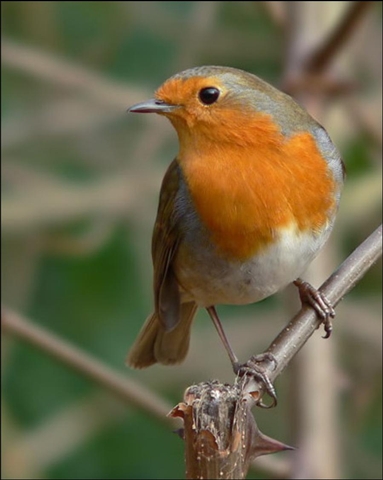Robin

Robins in the UK are associated with Christmas, and appear on lots of Christmas cards. A common explanation is that the Victorian postmen who delivered Christmas cards wore red uniforms, and were nicknamed "robin redbreasts". So people associated receiving their cards with Robins. The truth is probably much simpler, for Robins are most noticeable at Christmas. With bright red breast, which the bird puffs out to keep warm, and winter song, these birds bring colour and cheerfulness to drab surroundings. Robins are one of the few species of bird that sing in winter. It is also in the depths of winter, when insect food is scarce, that Robins seem most tame. So Robins have become as much a part of the Christmas scene as snow and holly.
A rich folklore surrounds the robin, which has always been seen as a friend to people, and an emblem of charity and piety. So William Shakespeare described the "ruddock with charitable bill" while William Wordsworth asked,
"Art thou the bird whom Man loves best
The pious bird with the scarlet breast
Our little English Robin?"
Pious is poetical license. Robins are aggressive and have been known to defend their food territories to the death. Robins sing throughout the year because each bird, male or female, will occupy its own territory during the winter. In order to defend their winter food territories, the females have to sing and display just like males do. Then in spring the females have to persuade the males to stop fighting them and start co-operating with them in the raising of a family. To do this, when they encroach into the
males’ territory they behave like young birds begging for food, thus stimulating the males to feed them rather than fight them.
The sexes are very similar, if not identical. Some texts suggest that the brown forehead is "V" shaped in females, and "U" shaped in males, though even this is not always apparent.
The juvenile Robin has speckled buff-brown upper parts and underparts. They have no red feathers so that adult birds do not attack them in territorial disputes. The speckled feathers are lost in a partial moult when the bird is about two to three months old.
In winter, resident birds in the UK are joined by some immigrants from Scandinavia and continental Europe. A small percentage of British females winter abroad. Large numbers of birds from northern Europe pass through Britain in the autumn before continuing to Iberia and North Africa to winter.